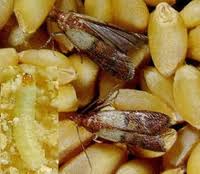The Indian meal moth is one of the most prevalent minor pests in the world. This small, brown, innocuous looking moth gets into dry grain stores and ruins them by laying eggs that soon hatch into larvae nicknamed “waxworms†…
The Indian meal moth feeds on grain and is found around the world. While not harmful, they are not sanitary and are considered pests. Fortunately, the Indian meal moth can be easily controlled with methods that are non-toxic.
The Indian meal moth’s scientific name is Plodia interpunctella. It is also called the North American High Flyer. It is a moth that starts as an egg, then progresses to a small larval worm that pupates, and then becomes an adult.
The reason they are considered such a pest is that they can get into containers that you wouldn’t think they could penetrate, such as Tupperware containers or sealed bags. Once into a supply of grain, the females lay from 60 to 400 eggs right on the food surface. They hatch somewhere from two to 14 days later. The larvae are also called “waxworms,” a descriptive term for their appearance. They have off-white bodies and brown heads. The larvae are about a centimeter long. Depending on the temperature, the larval stage lasts from two to 41 weeks.
Often Indian meal worms are not discovered until a contaminated container of dry grain is opened. Rather than being dry and pourable, the grains feel as if they are somehow webbed together, and are slightly sticky. Often you will see eggs and larvae in a contaminated source of meal. While not poisonous, these creatures, discovered in a container of dry grain, can certainly induce nausea!
To get rid of Indian meal moths, it is necessary to throw out any contaminated grains as well as grains that are not in tightly sealed containers, as they may have been contaminated, too. The larvae are able to travel fairly long distances before they pupate, so pupae may be found far from the contaminated grain source.
To prevent infestation of Indian meal moths, you can place a bay leaf into a food container with non-contaminated grains. Very simple and non-toxic traps are available that will inhibit the development of adult moths. Traps with lures may simply have sticky walls on the inside. Sometimes, they don’t even need a lure – just a standard glue trap.
You’ve no doubt seen the adult moths even if you’ve been fortunate enough not to encounter the larvae or pupae. They’re about a centimeter long with wingspans of 1.5 to 2 cm. They are bronze, copper, or dark gray, with a dark band across the middle of the wings and outer wings that are yellow-gray. Depending on how long the temperature dictates that they remain larval, the entire life cycle can be 30 to 300 days long.





